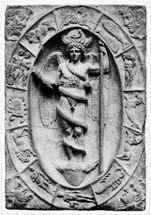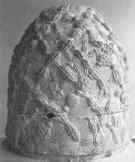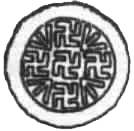HELLENIC RELIGION
Orphean Cosmogony is the
oldest existing description of the creation of the World,
or, more precisely, the Cosmos.In the Hellenic language, Cosmos literally means ornament, coming from the verb "cosmoo", meaning to adorn, later to embellish. The Stoics, the philosopher Hellanikos and others have also described identically the process of creation, but each with his own mystical
terminology. In antiquity, the ones who knew were bound not to reveal these things to the
public, as this was considered a blasphemy. Cosmological knowledge was sacred. It derived
from the «Golden Epoch» of Mankind (Golden as used by
Hesiodus). It was preserved by
mystics, as religious knowledge, during the long ages of regression of human civilization,
that followed the floods (of Ogygos and Deukalion) and other delusionary events. In the
present day, scientific knowledge is so disseminated, that this mystic prohibition is
useless and obsolete. Orphean Cosmogony - The Basic Principles
Hellenic Religion - Orphean Cosmogony 
What is a Universe?
Orphean Cosmogony - The Basic Principles
Hellenic Religion - Orphean Cosmogony 
What is the Cosmos?The Cosmos is conceived as the frame in which Universes exist. It is the ultimate, infinite open system, consisting of a multitude of Universes. It always existed and it always will. Outside Universes, space exists, as well as other entities (Substances), in a non-manifest, pre-creational state.
Orphean Cosmogony - The Basic Principles
Hellenic Religion - Orphean Cosmogony 
How is the Pre-Creational state possibly conceived?According to the Hellenic religion, before the creation of the Universe, there existed the «Unspeakable Principium», which, in Orphean Cosmogony stands for «pre-creational state». It emphasizes the paucity of expressive means to describe it, or maybe the holliness of it, imposing a mystical or religious prohibition. Another name for the pre-creational state in Orphean Cosmogony is «Pre-creational Unit», emphasizing the physical unity of its components. As an entity, the Unspeakable Principium is elusive, because it is beyond ordinary experience; theologically speaking, no God will ever be able to understand. Of all the philosophical entities that constitute the Unspeakable Principium, two are Cosmogonic Substances. Space, extending infinitely in all dirrections, and Time, perpetually running, without any specific starting point. These two philosophical substances correspond to the present-day relativistic conception of the 4-dimentional Spacetime. Orphean Cosmogony - The Basic Principles
Hellenic Religion - Orphean Cosmogony 
The Continuous Substance: TautonThe Continuous Substance, of radiationnal nature, corresponding to the present-day conception of «zero-point radiation field». This field cannot be detected, as such, within the Universe, because its energy has been locally consumed to form the Universe, as a result of a reaction with the Substance that follows. Nevertheless, a remnant of this radiationnal field can always be detected, as the so-called «cosmic radiation». The primordial zero-point radiation field infiltrates the inter-universal Space, and, interestingly, has the same intensity everywhere. The meaning of this is that, either the field stands by itself, with no causative agent, or the field is a property of the infinite Space. In terms of Orphean Cosmogony, the primordial Continuous Substance is called «Aether» emphasizing its subtleness and ability to infiltrate everything else, while Pythagoras called it «Finite» and «Unit», and others other mystical names. Orphean Cosmogony - The Basic Principles
Hellenic Religion - Orphean Cosmogony 
The Particulate Substance: HeteronThe Particulate Substance, the primordial matter, is made up of sub-atomic particles, standing at the edge of existence and non-existence. The conception for the primordial matter is a direct derivative of the Uncertainty Principle. According to this principle,
sub-atomic particles can and will be temporarily brought into existence. The product of
their mass to the duration of their life, must and will be less than the Plank constant. Orphean Cosmogony - The Basic Principles
Hellenic Religion - Orphean Cosmogony 
The Divine Natural LawThe Divine Natural Law exists perpetually, always the same, even in the pre-creationnal state, mostly as virtual law, but only because there is no substrate for it. In fact, it will take effect, as soon as the appropriate physical conditions exist: For instance, in order that the laws of hydraulics take effect, it is mandatory that fluid chemical substances are first created. The laws are inherent in the manifest matter, as well as in the pre-creational state. Some laws are operational even in the Unspeakable Principium: The primordial Law of Motion and the Law of Conservation have already been mentioned. The Law of Interaction of Substances will be mentioned shortly. In Orphean Cosmogony, this Law has been personified mythologically, as Eros. The Natural Law is supervised by higher order Divine selves, the Deities of the Night (Adrasteia, Nemessis and their servants, the Erynies etc). These Deities pre-exist our own Universe; they have not evolved in it, but in another Universe of the Cosmos, older than ours. Orphean Cosmogony - The Basic Principles
Hellenic Religion - Orphean Cosmogony 
The creation outlineAccording to the Hellenic religion, manifest matter of the Universe stems from the reaction of the two Cosmogonic Substances that were mentioned earlier, namely the Continuous and the Particulate Substance. This reaction is governed by the divine Law of Interaction of Substances (Eros), while the conditions in which the reaction will take effect are governed by the divine Laws of Motion and Conservation. The frequency with which new Universes are created is governed by the divine Laws of Stochastic Mechanics and Chaotic Dynamics. Orphean Cosmogony - The Basic Principles
Hellenic Religion - Orphean Cosmogony 
Sacred InteractionsVery seldom in eternity, the oscillations of the cells of Spacetime, caused by the aforementioned abortive appearances of primordial Matter (Particulate Substance), are so
intense that the curvature of Space becomes temporarily very pronounced. This means that a
huge amount of mass is present at that particular location, causing a very strong
gravitationnal field. Orphean Cosmogony - The Basic Principles
Hellenic Religion - Orphean Cosmogony 
From Oion to Phanes (From Fireball to Proto-universe)The Oion contracts unevenly (the core contracts more), because of the degrading intensity of the gravitationnal field, from the center outwards. Gravity is so strong, that nothing escapes; not even light. At some point, the gravitationnal forces are superceded by the pressure (thermal forces) at the core, and, as the pressure in the outer part is smaller, the core explodes. For the first time light can travel outwards, and consequently, a splendid luminus phenomenon is produced. In Orphean Cosmogony, this is called Phanes, because it is the epiphany of the newly formed Universe. Phanes carries other names too, depending on the properties emphasized: Metis (volitional), Erikepaius (impregnative), Eros (creative) and also Protogonos (primeval, took shape for the first time). Orphean Cosmogony - The Basic Principles
Hellenic Religion - Orphean Cosmogony 
Compliance with Scientific knowledgeIn the previous paragraphs, the initial steps of «creation» of the primeval Universe
and the uncommon conditions that preceded it, were presented. It was made clear that the
Cosmology of the Hellenic traditional religion is absolutely compliant with present-day
Physics (Relativity, Quantum mechanics, Nuclear physics), Mathematics (post-Eucledian
Geometries, Topology), Astronomy and Cosmology, and the theory of non-linear Dynamics
(Chaos). Orphean Cosmogony - The Basic Principles
Hellenic Religion - Orphean Cosmogony 
Tribute to the old-time thinkersA word should be addressed in honour of all those initiated thinkers that preserved the Hellenic traditional religion through the dark centuries of Byzantine, Othomman and Catholic Middle Age; and also of those few who withstood the pressure of rationalistic science of the 19th century. Thanks to them, our religion survived; Underground, yes; with persecutions, yes; with the precious manuscripts of the philosophers in ashes, yes; without solemn worship, yes; with our glorious temples demolished, yes; even the marble remnants were put in the lime-kilns; but it did survive to the present day. Some, or maybe most, of those thinkers did not understand a single word of the Cosmogony, due to the poor advancement of Physics, in their time. But they insisted, persuaded for the wisdom of the sacred Word of Orpheus. After so many years, our generation, for the first time, is in the favourable position to partly understand this wisdom of our ancestors, under the light of modern science. Orphean Cosmogony - The Basic Principles

Helliniki Hetaireia Archaiophilon
Back to Top
|

 A Universe, is an immense cogglomerate of matter (meaning the total of matter and energy of course). It came into existence at a definite point in time, and it is finite in space. Its course is cyclic, meaning that, once created, it will expand up to some point and then contract back
to its initial (created) state, and then expand again and contract again, infinitely. In Orphean terminology, expansion of the Universe is called Diacosmesis (adornement), while contraction is called Ekpyrosis (heating to the ultimate). This course of events is best described (in my opinion) by Herakletus. The age of our Universe is estimated between 16 and 18 billion years, counting from its latest collapse by Ekpyrosis. It is absolutely certain that our Universe is still expanding. It is estimated that, at the age of approximately 18 bil. years, it will start contracting for another 18 bil. years. In the large scale, the Universe is isotropic.
A Universe, is an immense cogglomerate of matter (meaning the total of matter and energy of course). It came into existence at a definite point in time, and it is finite in space. Its course is cyclic, meaning that, once created, it will expand up to some point and then contract back
to its initial (created) state, and then expand again and contract again, infinitely. In Orphean terminology, expansion of the Universe is called Diacosmesis (adornement), while contraction is called Ekpyrosis (heating to the ultimate). This course of events is best described (in my opinion) by Herakletus. The age of our Universe is estimated between 16 and 18 billion years, counting from its latest collapse by Ekpyrosis. It is absolutely certain that our Universe is still expanding. It is estimated that, at the age of approximately 18 bil. years, it will start contracting for another 18 bil. years. In the large scale, the Universe is isotropic.



